This article's tone or style may not reflect the encyclopedic tone used on Wikipedia.(July 2023) |
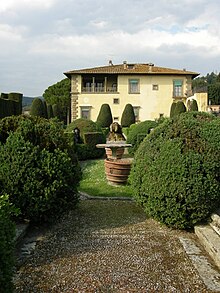 Villa Gamberaia in 2011 | |
 | |
| Location | Florence - Italy |
|---|---|
This article's tone or style may not reflect the encyclopedic tone used on Wikipedia.(July 2023) |
 Villa Gamberaia in 2011 | |
 | |
| Location | Florence - Italy |
|---|---|
Villa Gamberaia, built in the Tuscan style by the Florentine gentleman-merchant Zanobi Lapi in the early 1600s, is located on the hillside of Settignano, overlooking the city of Florence, Italy and the surrounding Arno Valley. [Fig. 1 View from the upper terrace] [1]
The villa is celebrated for the unique design of its gardens, originally laid out by Zanobi Lapi and his nephews in the first half of the seventeenth century and preserved until now with few major changes. [2] According to Edith Wharton, the Gamberaia was "probably the most perfect example of the art of producing a great effect on a small scale". [3] The design has inspired landscape and garden architects throughout the world, including Charles Platt, A. E. Hanson, and Ellen Shipman in the United States and Cecil Pinsent and Pietro Porcinai in Italy and the UK. [4] In 2010 the Gamberaia was chosen as the model for the "RCSF Tuscan garden", recreated at Snug Harbor, Staten Island, New York. [5]
The Beginnings
The first mention of the property dates to the late fourteenth century and refers to the grant to Giovanni Benozzo in 1398 of a farm and house in the place called Gamberaia by the Abbess of San Martino a Mensola. The place-name "gamberaia" probably refers to the farming of fresh-water shrimp in local ponds. During the fifteenth and sixteenth centuries a house with land, in part cultivated, in part planted with vineyards belonged to the Gamberelli family: Matteo, his sons, among whom the well-known sculptors and architects Antonio and Bernardo "Rossellino", and their descendants. [6]
The Lapi Era, 1610 - 1718
In 1610 the property was acquired by Zanobi Lapi, a wealthy and cultivated Florentine merchant with ties to the Medici court, and it is he and his nephews who were responsible for the construction of the villa, on the foundations of an earlier casa da signore, and the subsequent layout of the gardens. Evidence of Lapi ownership and patronage is visible in an inscription on the architrave of a door inside the east entrance to the villa ("Zenobius Lapius erexit ac fundavit A.D. MDCX") and in the heraldic lions carved on vases above the gate to the gabinetto rustico and in the relief sculptures of the nymphaeum (or 'Neptune grotto'). Documents of Zanobi's time mention a limonaia, a lawn area, and ilex woods, which remain essential parts of the garden plan, and the conduits that convey water from the springs above the nymphaeum to the several fountains, a complex hydraulic system that still functions today. The architects who built the villa and carried out the massive engineering project that extended the main terrace of the villa to the south, thus creating the long north-south axis of the bowling green and the area of the parterre, have not been identified. Recent studies, however, point to the Florentine architectural tradition of Bartolomeo Ammannati, Bernardo Buontalenti, and Giovanni Battista Caccini and the influence in the gardens and grottos of the theatrical designer Giulio Parigi. [7]
The Capponi Era, 1718 – 1854
In 1718, as the fortunes of the surviving Lapi declined, the property was divided between the Capponi and Cerretani families. The villa with its formal gardens passed to Piero and Vincenzo Capponi, who undertook its restoration. The Capponi estate map, or cabreo, dating to c.1725, documents their improvements and embellishments, notably in the addition of busts and statues (allegories of the seasons) in the gabinetto rustico. [8] The etching of the villa by Giuseppe Zocchi, included in his Vedute delle Ville e d'altri luoghi della Toscana of 1744, depicts its handsome façade facing Florence, the series of terraces on which the house and gardens were constructed, the recent planting of young cypresses along the entrance road and southern edge of the garden avenue, and the fountain displays. Two other etchings show the entrance gate on via del Rossellino and the country roads skirting the villa to the northeast. Zocchi's prints were especially popular among visitors on the Grand Tour and reveal the growing international prestige of the Gamberaia.
The Second Half of the Nineteenth Century
Following the sale of the villa in 1854 by the last Capponi owner to Pietro Favreau of Guadaloupe, [9] the property passed to members of the D’Outreleau family and, in turn, to the Fazzini, but from the 1890s it appears to have become increasingly neglected. Carlo Placci, Serge Wolkonski, and Gabriele D’Annunzio, who visited the gardens in the 1890s, all noted signs of decay – though they also felt its mysterious, poetic atmosphere.[i] It was in fact the very silence and tranquility of the place that attracted the Romanian princess Catherine Jeanne Ghyka, sister of Queen Nathalie of Serbia, and inspired her to purchase the villa in 1896 [10]
The Women of the Gamberaia, 1896-1952
In the following years, 1898-1900, Princess Ghyka undertook the most audacious intervention in the garden since its creation—and the only major innovation to date—replacing the old flower beds of the Capponi parterre, which in the meantime had deteriorated into a mere kitchen garden, with elegant, mirror-like pools, bordered with colorful flowering plants. Although initially the new design drew both criticism and applause, [11] the parterre d'eau soon became the iconic feature of the Gamberaia, painted, photographed, and studied by artists, architects, and garden lovers from around the world.
The gardens were also a favorite gathering place for friends and families of Pr.ss Ghyka and her American companion, the artist Florence Blood, and of Anglo-American and European expatriates who made their homes on the hills of Settignano and Fiesole, among them Benard and Mary Berenson at Villa I Tatti, Janet Ross at Poggio Gherardo, Vernon Lee at Il Palmerino, and Sybil Cutting and Geoffrey Scott at Villa Medici. Neighbors and visitors also included Leo and Nina Stein, Neith Boyce and her husband Hutchins Hapgood, the artist Edward Bruce, the stage and costume designer Léon Bakst, the sculptor Adolf von Hildebrand, the collectors of Cézanne Egisto Fabbri and Charles Loeser, and Arthur Acton. As Bernard Berenson later recalled, "for years Gamberaia remained one of the fari [beacons], one of the haunts of my life." [12]
It was not long, however, before WWI and the Russian Revolution disrupted the leisurely and relatively carefree life-style of the two women at the Gamberaia. In 1925 Florence Blood died after a long illness contracted during her hospital service in France during the war and Princess Ghyka, who had lost most of her lands and their revenues during the Russian Revolution, sold the villa and retired to a smaller house nearby. It was said that she did not approve of the changes that the new owner, the American-born Maud Cass Ledyard, widow of the German diplomat Baron von Ketteler, made in the parterre, where the flowering borders of the pools were replaced with trimmed box and sculpted yews and cypress, creating a more formal, evergreen and architectonic effect in the Neo-Renaissance style.
During WWII the villa was expropriated by the Fascist government (along with other properties throughout Italy belonging to Jews and citizens of 'enemy nations') and occupied in part by the Istituto geografico militare di Firenze and in part, from the spring of 1944, by a German command. In August it was devastated by fire set by the retreating German forces, destroying most of the interior. In 1952 Baroness von Ketteler, who had returned to the States, donated the property, which she had left in the hands of her caretaker, to the Vatican.
Recent History, 1954 to the present
The recent history of the property is linked to the name of Marcello Marchi, a Florentine industrialist who acquired the villa from the Vatican in 1954 and who worked closely with the architect Raffaello Trinci to rebuild and renovate the house and restore the gardens. In 1956 they were declared of national historic and artistic importance and opened to the public. A decade later the Hungarian-American architect and photographer Balthazar Korab immortalized the gardens in his famous photographic essay, Gamberaia. [13]
In 1994 the property passed to Franca Marchi (d. 1998) and her husband Luigi Zalum, who has continued to improve and enhance the villa and gardens and provide a venue for private events and cultural initiatives.
History and Design of the Villa and Gardens
Villa Gamberaia: Sources and Interpretations, special issue of Studies in the History of Gardens & Designed Landscapes, 22 (2002), guest ed., P. Osmond.
Includes essays on the Gamberaia by Mario Bevilacqua, Marcello Fagiolo, Maia Gahtan, Margherita Caputo, Patricia Osmond, Vincenzo Cazzato.
Revisiting the Gamberaia: An Anthology of Essays, ed. with Preface, Introduction, and Notes by P. J. Osmond
Includes historic essays on the Gamberaia (1901-1973) by Janet Ross, Edith Wharton, E. March Phillipps (with photos by Charles Latham), H. Inigo Triggs, Henry V. Hubbard, Geoffrey Jellicoe (with drawings by J.C. Shepherd), Georgina Masson, and Harold Acton, with Introduction, prefaces to each essay, and notes.
Judith Kinnard, ““The Villa Gamberaia in Settignano: The Street in the Garden,” Journal of Garden History 6 (1986): 1-18.
Gian Luca Simonini. “Il giardino di Gamberaia e l’addizione di Catherine Jeanne Ghyka,” Storia urbana 85 (1998) 151-70.
Luigi Zangheri,. "Pietro Porcinai e La Gamberaia," in I giardini del XX secolo: l'opera di Pietro Porcinai, ed. Maria Chiara Pozzana (Florence: Alinea, 1998), 131-138.
_____________. “Islamische Einflüsse in der Europäischen Gartenkunst am Beispiel der Villa Gamberaia,” in Historische Gärten heute, ed. M. Rohde and R. Schomann (Leipzig: 2003), 52-57.
Guides
Mariachiara Pozzana, Villa Gamberaia (Florence: Edizioni Casalta, 2015).
Photographic Studies
Balthazar Korab, Gamberaia. Photo essay, with text by Harold Acton. (Florence: Centro Di, 1971).
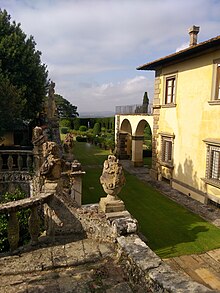
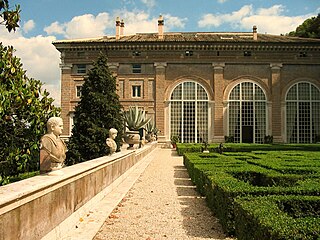
Villa Madama is a Renaissance-style rural palace (villa) located on Via di Villa Madama #250 in Rome, Italy. Located west of the city center and a few miles north of the Vatican, and just south of the Foro Olimpico Stadium. Even though incomplete, this villa with its loggia and segmented columned garden court and its casino with an open center and terraced gardens, was initially planned by Raphael, and highly influential for subsequent architects of the High Renaissance.

The Villa Farnese, also known as Villa Caprarola, is a pentagonal mansion in the town of Caprarola in the province of Viterbo, Northern Lazio, Italy, approximately 50 kilometres (31 mi) north-west of Rome. This villa should not be confused with the Palazzo Farnese and the Villa Farnesina, both in Rome. A property of the Republic of Italy, Villa Farnese is run by the Polo Museale del Lazio.

Villa La Pietra is a renaissance villa in the hills outside Florence, in Tuscany in central Italy. It was formerly the home of Arthur Acton and later of his son Harold Acton, on whose death in 1994 it was bequeathed to New York University. The villa is now home to NYU Florence.

The Villa Doria Pamphili is a seventeenth-century villa with what is today the largest landscaped public park in Rome, Italy. It is located in the quarter of Monteverde, on the Gianicolo, just outside the Porta San Pancrazio in the ancient walls of Rome where the ancient road of the Via Aurelia commences.

Settignano is a frazione on a hillside northeast of Florence, Italy. The little borgo of Settignano carries a familiar name for having produced three sculptors of the Florentine Renaissance, Desiderio da Settignano and the Gamberini brothers, better known as Bernardo Rossellino and Antonio Rossellino. The young Michelangelo lived with a sculptor and his wife in Settignano—in a farmhouse that is now the "Villa Michelangelo"— where his father owned a marble quarry. In 1511 another sculptor was born there, Bartolomeo Ammannati. The marble quarries of Settignano produced this series of sculptors.

The Villa Medici at Careggi is a patrician villa in the hills near Florence, Tuscany, central Italy.
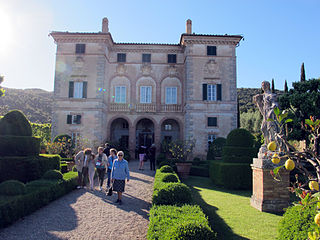

Villa Palmieri is a patrician villa in Fiesole, central Italy, that overlooks Florence. The villa's gardens on slopes below the piazza S. Domenico of Fiesole are credited with being the paradisal setting for the frame story of Boccaccio's Decameron.

The Villa del Trebbio is a Medici villa in Tuscany, Italy.

The Villa Torrigiani is located in the hamlet of Camigliano, a town in Capannori (Lucca). It is a historical villa, dating from the second half of the sixteenth century.

Gardens of the French Renaissance were initially inspired by the Italian Renaissance garden, which evolved later into the grander and more formal jardin à la française during the reign of Louis XIV, by the middle of the 17th century.

Italian garden typically refers to a style of gardens, wherever located, reflecting a number of large Italian Renaissance gardens which have survived in something like their original form. In the history of gardening, during the Renaissance, Italy had the most advanced and admired gardens in Europe, which greatly influenced other countries, especially the French formal garden and Dutch gardens and, mostly through these, gardens in Britain.

Villa I Tatti, The Harvard Center for Italian Renaissance Studies is a center for advanced research in the humanities located in Florence, Italy, and belongs to Harvard University. It houses a collection of Italian primitives, and of Chinese and Islamic art, as well as a research library of 140,000 volumes and a collection of 250,000 photographs. It is the site of Italian and English gardens. Villa I Tatti is located on an estate of olive groves, vineyards, and gardens on the border of Florence, Fiesole and Settignano.
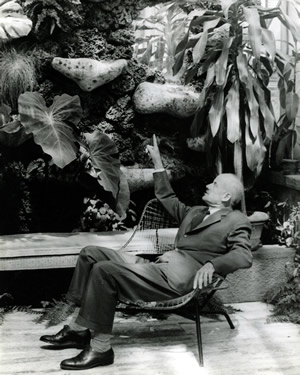
Pietro Porcinai is renowned as one of the most outstanding Italian landscape architects of the twentieth century. He designed a wide variety of projects on the most diverse scales: gardens and public parks, industrial districts, hotels and tourist villages, motorways and agricultural areas. The hundreds of projects implemented in Italy and abroad comprise the most extraordinary “landscaped” gardens, perfectly integrated within the surroundings and so natural as to appear untouched by human hand.
Cecil Ross Pinsent FRIBA was a British garden designer and architect, noted for the innovative gardens which he designed in Tuscany between 1909 and 1939. These imaginatively re-visited the concepts of Italian 16th-century designers.

The Baroque garden was a style of garden based upon symmetry and the principle of imposing order on nature. The style originated in the late-16th century in Italy, in the gardens of the Vatican and the Villa Borghese gardens in Rome and in the gardens of the Villa d'Este in Tivoli, and then spread to France, where it became known as the jardin à la française or French formal garden. The grandest example is found in the Gardens of Versailles designed during the 17th century by the landscape architect André Le Nôtre for Louis XIV. In the 18th century, in imitation of Versailles, very ornate Baroque gardens were built in other parts of Europe, including Germany, Austria, Spain, and in Saint-Petersburg, Russia. In the mid-18th century the style was replaced by the less geometric and more natural English landscape garden.

The Palazzo Panciatichi is a Renaissance palace located on Via Camillo Cavour 2 in the quartiere of San Giovanni, Florence, region of Tuscany, Italy. A different Palazzo Panciatichi-Ximenes or Ximenes-da Sangallo is located at Borgo Pinti 68, corner of via Giusti, in Florence.

The Villa di Marignolle is a Medici villa in the hills between Galluzzo and Soffiano, in the south-western suburbs of the comune of Florence, in Tuscany in central Italy. It passed into the hands of the Medici family after the Pucci Conspiracy, when it was confiscated from Lorenzo di Piero Ridolfi by Francesco I de' Medici, Grand Duke of Tuscany. Francesco passed it to his illegitimate son Antonio.
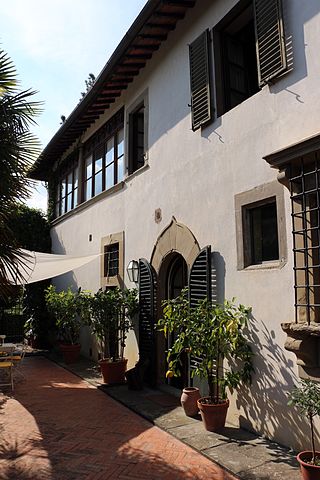
Villa il Palmerino is a villa in Settignano, in the north-eastern part of the city of Florence, in central Italy. It lies in the hills below Fiesole, close to the frazione and convent of San Domenico. From about 1889 it was the home of the British writer Violet Paget, who wrote under the pseudonym "Vernon Lee", and was at that time also known as Villa Paget.
Diego Suarez was a garden designer best known for his work at James Deering's Villa Vizcaya in Miami, Florida. He also served as a press attaché and minister-counselor for Chile in Washington, D.C. from 1948 until 1952 and counselor to the Colombian delegation to the United Nations.